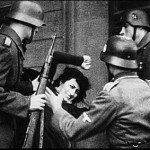Neo-realism is one of those tricky cinema terms bandied around by critics and the like but many have little appreciation for what it represents, particularly towards Italy, and its contribution to cinema. While only a small movement (if you can call it that), it showed Fascist Italy to the world as melodramatic. To Italians, it provided an escape; creation of characters and stories that still presented real issues but at the same time resisting the constraints of the regime. Roberto Rossellini’s Roma, citta aperta (Open City) is the most famous example of showing how Italians see this era in their history.
Federico Fellini quoted neo-realism as “a way of seeing reality without prejudice, without conventions coming between it and myself”, but it’s hard to define – there are only about 90 films post-WWII that can be classified as neo-realism, stories presented with a more ‘stained’ reality. Open City, an early neo-realist film from 1945, shows the fact of Nazi-occupied Rome within the narrative: Giorgio Manfredi, part of the Resistance, is on the run from forces and seeks refuge with the help of priest Don Pietro, friend Francesco and his pregnant fiancé Pina. Rome, along with Paris, was an ‘open city’ during WWII –neutral, but occupied by the Germans as part of the country’s north. Allies captured the South and ousted Mussolini in 1943, creating another divide in the north-south relations within Italy. It led to the change of Italy’s social structure; the Fascists’ idea of a well-run society differed enormously to the commoners’ reality of poverty and illiteracy. Rossellini shows this in Open City in his desire to represent the truth of the Nazis’ controlling ‘power’ versus how the people resist the forces. This is most prevalent with the common motif of faith.
 |
As in the previous Retrospective films, Open City has a religious undertone that holds an important place in Italian society. In this film, faith stands as the hope for an overturn of Fascism and the creation of a new Italy. Don Pietro’s presence in the film is imperative because of the slight contradiction it presents. Although his neutrality is expected as a priest, he’s the middle man in between Francesco and the military junta in helping the Resistance, and ultimately between Francesco and the Nazis. Rossellini presents him comically as a form of objective reality through scenes such as the slapstick of knocking out Pina’s father with a frying pan, and dramatically while discussing faith and identity with Pina. Contrary to other neo-realist films, the tight narrative within intertwining subplots gives Open City gives that much more to the viewer – in the final stages of the film, Manfredi is presented like Christ, with cuts across his body, and his body positioned limp and helpless (much like Peppino in The Hundred Steps). While showing a reality, we don’t forget that the projection is shown through cinematic conventions.
Oh it’s not difficult to die well. The difficult thing is to live right.
The production of Open City not only affected the emergence of neo-realism but has a lot to say about the state of Italy at the time. Rossellini had an early background in documentaries, so had no problem with location shooting and providing an objective presentation of events. The problem came with the film itself – celluloid was made using the same chemicals as gunpowder, which was problematic throughout the war. Little equipment was left when the Germans retreated in 1945 and Rossellini scrounged what he could to make the film. What resulted was the grainy effect and different lighting within scenes presented to us in Open City and encapsulates the objectivity that neo-realism strives for. It’s been suggested that this isn’t just politically relevant, but acts as a statement about the importance of film in politics. Open City led to accusations of Communist, or at least Left-wing, preferences on Rossellini (the Christian Democratic group in power were Right-wing, who later censored many neo-realism films).
 |
The film itself speaks as a politically-charged piece on how Italians resisted against the Nazi forces but speaks to its countrymen as a film about identity – creating a new Italy away from the Fascism and Communism that divided so many politically, socially and economically. It’s impossible to talk about Open City without mentioning its most poignant and unexpected scene – Pina’s death. It stands as one of the most iconic in cinema history not only as a produced moment but as a message of humanity. The heroine of the film is a sympathetic but unconventional woman (she’s having a kid before marriage!) and although one of Rossellini’s constructed stereotypes, acts as the moral example. When she runs for Francesco past the Nazis we see the resistance – her eyes are only for her love; a metaphor for Italy resisting outside forces and yearning for societal change. Rossellini’s ‘ellipsis’ technique sees a distortion of the on-screen space to create closeness and here serves to inform the viewer of what Open City represents.
Winning the inaugural Palme d’Or at Cannes and the Foreign Film Oscar in 1946, Open City made a star out of Anna Magnani (Pina) and was a box office hit. The same can’t be said for later neo-realist films as Italians turned to Hollywood escapism amid censorship enforced by the Christian Democrats. What resounds with this film is that there is a defined good and evil within the story and the characters, presented in such a way that Italians could indirectly have a feel of the era. Rossellini shaped a form of filmmaking with Open City and helped international audiences as well as his own to see how Italy dealt with the WWII occupation and how it saw itself as a country at the time – divided and broken, but with hope. It is open about its ‘stained’ reality and is striking in its sense of a fragmented society – Rossellini couldn’t have done a more intriguing job.
 Follow the author Katina Vangopoulos on Twitter.
Follow the author Katina Vangopoulos on Twitter.















![The Three Musketeers [2011] (Review)](/wp-content/uploads/the-three-musketeers-21-e1319607229980-150x150.jpg)